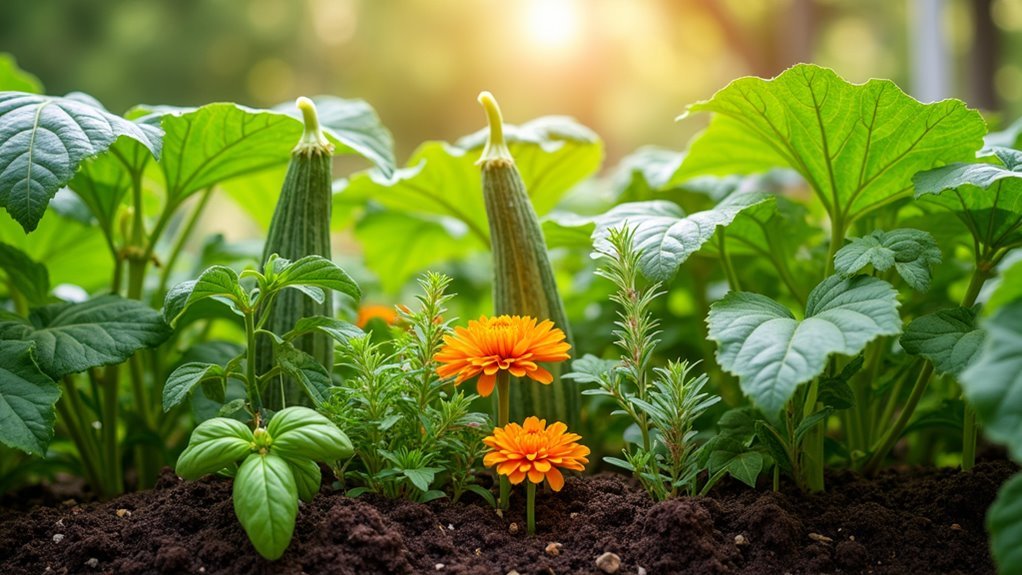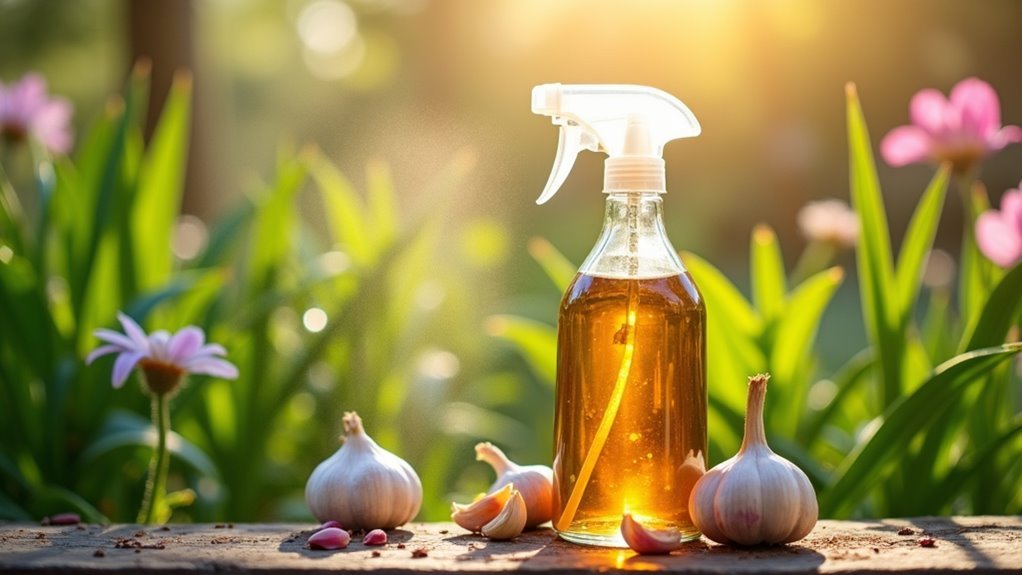You’ll protect your three sisters garden by spacing corn clusters 6 inches apart with beans around the perimeter and ground-covering squash beneath. Plant aromatic companion herbs like basil, marigolds, and nasturtiums to repel pests and attract beneficial insects. Time your plantings strategically—corn in early spring at 60°F, beans 2-3 weeks later, then squash after frost danger passes. Monitor plants weekly for early pest detection, focusing on leaf undersides where harmful insects typically hide. These techniques will reveal even more powerful natural pest control strategies.
Strategic Plant Spacing to Maximize Natural Pest Barriers

When you’re planning your Three Sisters garden, strategic plant spacing creates multiple layers of natural pest protection that work together as a unified defense system.
Position your corn in clusters spaced 6 inches apart to form the foundation tier, while placing beans around the perimeter where they’ll climb effectively and fix nitrogen for improved plant health.
Space your squash to cover ground thoroughly, creating natural pest barriers through their broad leaves that also provide excellent weed suppression.
This three-tier approach disrupts pest movement patterns and enhances biodiversity.
Add companion plants like marigolds or nasturtiums along garden borders to strengthen these defenses and attract beneficial insects, completing your all-encompassing pest management strategy.
Beneficial Insect Habitat Creation Within the Three Sisters System
Building on your strategic spacing foundation, you’ll want to focus on creating thriving habitats that welcome beneficial insects into your Three Sisters garden.
Incorporate flowering plants like sunflowers and cosmos throughout your Three Sisters layout for attracting pollinators and natural predators such as ladybugs and lacewings. This diverse planting approach enhances pest control while boosting biodiversity.
Intersperse aromatic herbs like basil, thyme, and dill among your corn, beans, and squash to repel harmful pests while drawing beneficial insects for natural pest management.
Create living fences with lavender or marigolds around your garden perimeter. The varied plant heights—from tall corn to sprawling squash—provide diverse microhabitats that support a balanced ecosystem essential for effective habitat creation.
Companion Herbs That Amplify Pest Repelling Properties

As you integrate companion herbs into your Three Sisters garden, you’ll discover that specific aromatic plants create powerful natural barriers against destructive pests.
These organic gardening allies work through companion planting principles, using their natural scents and properties to repel pests while supporting beneficial insects.
Strategic herb placement transforms your Three Sisters into a thorough natural pest control system:
- Basil, mint, and rosemary – These aromatic herbs deter aphids and cabbage moths through their strong scents.
- Chives – Effectively repel destructive nematoides while attracting beneficial insects for enhanced pest management.
- Nasturtiums – Function as excellent trap crops, drawing aphids away from your corn, beans, and squash.
- French marigolds – Release soil chemicals that eliminate harmful nematodes, protecting root systems.
This companion planting approach creates multiple defense layers without synthetic pesticides.
Timing Your Planting Schedule to Avoid Peak Pest Populations
Strategic timing becomes your most powerful weapon against pest invasions when you synchronize your Three Sisters planting schedule with natural pest cycles. Understanding pest emergence patterns helps you avoid peak pest populations that threaten your garden’s success.
| Plant | Timing | Soil Temperature | Purpose |
|---|---|---|---|
| Corn | Early spring | 60°F | Establish strong base before beans and squash |
| Beans | 2-3 weeks after corn | Warm soil | Fix nitrogen, use corn for support |
| Squash | After frost danger | Consistently warm | Minimize competition during plant growth |
| Staggered plantings | Every 2 weeks | ideal conditions | Reduce simultaneous pest infestation risk |
| Monitor pests | Late spring-summer | Rising temperatures | Track squash bugs and aphid activity |
Staggered planting prevents simultaneous vulnerability across your entire Three Sisters garden, spreading risk and maintaining healthier plant growth throughout the season.
Regular Monitoring Techniques for Early Pest Detection and Removal

While proper timing sets the foundation for pest prevention, your garden’s success depends on catching problems before they escalate into major infestations. Regular monitoring enables effective pest detection and early removal before damage occurs.
Success in gardening lies in vigilant observation—catching pest problems early before they transform into devastating infestations that destroy crops.
Implement these essential monitoring techniques for ideal pest management:
- Inspect weekly – Check plants thoroughly, focusing on leaf undersides where pests hide most frequently.
- Watch for warning signs – Look for wilting, discoloration, or abnormal appearances indicating pest problems.
- Use identification guides – Distinguish harmful insects from beneficial insects that support garden health.
- Monitor companion plants – Track how surrounding plants attract beneficial species for natural pest control.
Document observations consistently to improve your pest identification skills and future strategies. This systematic approach protects plant health while maintaining the delicate ecosystem balance essential for Three Sisters success.
Frequently Asked Questions
How Do the Three Sisters Shrug off Pests?
You’ll find corn supports beans for better air flow, squash shades soil preventing weeds, beans enrich soil creating healthier plants, and this diversity attracts beneficial insects that naturally control harmful pests.
What Is the Most Effective Pest Management?
You’ll find integrating companion planting with marigolds and basil most effective. They repel pests while you conduct weekly inspections for early intervention. Add diverse flowering plants to attract beneficial insects like ladybugs that naturally control harmful populations.
What Are the 7 Steps to Effective Pest Management?
You’ll follow seven steps: prevention, monitoring, identification, decision-making, implementation, evaluation, and adjustment. Start by preventing pests, monitor regularly, identify threats accurately, decide on actions, implement controls, evaluate effectiveness, then adjust strategies accordingly.
What Are the Three Basic Rules for Controlling Pests?
You’ll follow three basic rules for controlling pests: first, prevent problems by selecting resistant varieties and rotating crops; second, monitor regularly through plant inspections; third, intervene using biological controls or pesticides.
In Summary
You’ll protect your three sisters garden by implementing these integrated pest management strategies. Space your plants strategically, encourage beneficial insects, and plant companion herbs that naturally repel pests. Time your plantings to avoid peak pest seasons, and you’ll minimize infestations before they start. Don’t forget to monitor regularly—catching problems early saves you time and effort later. These methods work together to create a resilient, naturally balanced garden ecosystem.





Leave a Reply